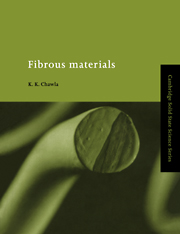Book contents
- Frontmatter
- Contents
- Preface
- Acknowledgments
- Chapter 1 Introduction
- Chapter 2 Fibers and fiber products
- Chapter 3 Natural polymeric fibers
- Chapter 4 Synthetic polymeric fibers
- Chapter 5 Metallic fibers
- Chapter 6 Ceramic fibers
- Chapter 7 Glass fibers
- Chapter 8 Carbon fibers
- Chapter 9 Experimental determination of fiber properties
- Chapter 10 Statistical treatment of fiber strength
- References
- Suggested further reading
- Appendix A Some important units and conversion factors
- Author index
- Subject index
Chapter 10 - Statistical treatment of fiber strength
Published online by Cambridge University Press: 13 October 2009
- Frontmatter
- Contents
- Preface
- Acknowledgments
- Chapter 1 Introduction
- Chapter 2 Fibers and fiber products
- Chapter 3 Natural polymeric fibers
- Chapter 4 Synthetic polymeric fibers
- Chapter 5 Metallic fibers
- Chapter 6 Ceramic fibers
- Chapter 7 Glass fibers
- Chapter 8 Carbon fibers
- Chapter 9 Experimental determination of fiber properties
- Chapter 10 Statistical treatment of fiber strength
- References
- Suggested further reading
- Appendix A Some important units and conversion factors
- Author index
- Subject index
Summary
Fracture of brittle materials, in general, involves statistical considerations. Materials have randomly distributed defects on their surfaces or in their interior. Fibrous materials, as we saw in Chapter 2, have a large surface area per unit volume. This makes it more likely for them to have surface defects than bulk materials. The presence of defects at random locations can lead to scatter in the experimentally determined strength values of fibers, which calls for a statistical treatment of fiber strength. Clearly, such scatter will be much more pronounced in brittle fibers than in ductile fibers such as metallic filaments. This is because ductile metals will yield plastically rather than fracture at a flaw of a critical size. Thus, most high performance fibers, with the exception of ductile metallic filaments, shows a rather broad distribution of strength because they are highly flaw sensitive. Since the distribution of flaws is of statistical nature, the strength of a fiber must be treated as a statistical variable. To bring home this important point of variation in strength of a fiber as a function of fiber length, we show, in Figs. 10.1–10.3, the variation of tensile strength of some fibers as a function of gage length: high modulus carbon fiber (Fig. 10.1), boron fiber (Fig. 10.2), and Kevlar 49 aramid fiber (Fig. 10.3). Intuitively, one can see that the probability of finding a critical flaw (which corresponds to the failure strength) increases as the volume of brittle material increases.
- Type
- Chapter
- Information
- Fibrous Materials , pp. 254 - 268Publisher: Cambridge University PressPrint publication year: 1998



